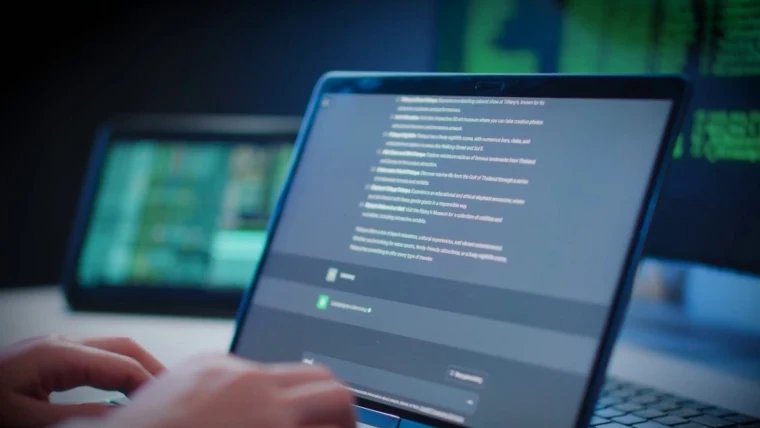Albert Edwards, the outspoken Global Strategist at Société Générale—a figure who even refers to himself as a “perma bear”—is certain that the current U.S. equity market, driven largely by high-flying tech and AI, is experiencing a dangerous bubble. (Société Générale, to be clear, does not hold the view that U.S. stocks or AI stocks are in a bubble, noting that Edwards is employed as the in-house alternative view.) While history often repeats itself, Edwards warned recently that the circumstances surrounding this cycle’s inevitable collapse are fundamentally different, potentially leading to a deeper and more painful reckoning for the economy and the average investor.
“I think there’s a bubble but there again I always think there’s a bubble,” Edwards told Bloomberg’s Merryn Somerset Webb in a recent appearance on her podcast Merryn Talks Money, noting that during each cycle, there is always a “very plausible narrative, very compelling.” However, he was unwavering in his conclusion: “it will end in tears, that much I’m sure of.”
Edwards told Fortune in an interview that previous theories about a bubble were “very convincing in 1999 and early 2000, they were very convincing in 2006-2007.” Each time, he said, the “surge in the market was so relentless” that he just stopped talking about bubbles, “because clients get pissed off with you repeating the same thing over and over again and being wrong,” only to change their tune after the bubble bursts. “Generally, when you’re gripped by a bubble, people just don’t want to listen because they’re making so much money.”
As he himself frequently points out, Edwards is known as a very bearish market strategist who has made some high-profile and dramatic predictions, often warning about major stock market crashes and recessions. His track record includes famously calling the dot-com bubble, but it also includes warnings that haven’t panned out, such as predicting a potential 75% drop in the S&P 500 from peaks—worse than the 2008 financial crisis lows. When The New York Times profiled Edwards in 2010, they noted that the chuckling, birkenstocks-wearing analyst had been predicting a Japan-style stagnation for U.S. equity markets since 1997 (a prediction he repeated in his interview with Fortune).
Still, Edwards insists that the current parallels to the late 1990s NASDAQ bubble are clear: extremely rich valuations in tech, with some U.S. companies trading at over 30x forward earnings, justified by compelling growth narratives. Just as the TMT (Technology, Media, Telecom) sector attracted vast, sometimes wasted, capital investment in the 1990s, Edwards argued that today’s enthusiasm echoes that earlier era. There are two key differences that could lead to a much worse outcome this time, though.
The Missing Trigger and the Meltup Risk
In previous cycles, Edwards explained, the catalyst for a bubble’s demise was usually the monetary authority’s tightening cycle—the Federal Reserve hiking rates and exposing market froth. This time, with the Fed lowering rates, that trigger is conspicuously absent. Bank of America Research has noted the rarity of central banks cutting rates amid rising inflation, which has occurred just 16% of the time since 1973. Ominously, BofA released a note on the “Ghosts of 2007” in August.
Instead of tightening, Edwards anticipates the Fed will move away from quantitative tightening and likely shift to quantitative easing “quite soon,” due to issues in the U.S. repo markets, another ghost from the Great Recession. The Fed itself issued a staff report in 2021 on repo issues, writing in 2021 that trading between 2007 and 2009 “highlighted important vulnerabilities of the US repo market.” Repo issues reemerged in the pandemic, with the Richmond Fed noting that interest rates “spiked dramatically higher” starting in 2019.
Edwards told Bloomberg that the absence of hawkish policy could lead to a “further meltup,” making the eventual burst even more damaging. Poking fun at himself, Edwards said, “I just got bored being bearish, basically rattling my chains saying, ‘This is all a bubble, it’s all going to collapse.’” He said that he can see how the bubble can actually keep going for much longer than a perma bear like himself would find logical, “and actually that’s when something just comes out the woodwork and takes the legs from out from under the bubble.”
“What’s more worrying about the AI bubble,” Edwards told Fortune, “is how much more dependent the economy is on this theme, not just for the business investments, which is driving growth,” but also the fact that consumption growth is being dominated far more than normal by the top quintile. In other words, the richest Americans who are heavily invested in equities, are driving more of the economy than during previous bubbles, accounting for a much larger proportion of consumption. “So the economy, if you like, is more vulnerable than it was in the ’87 crash,” Edwards explained, with a 25% or greater correction in stocks meaning that consumer spending will surely suffer—let alone a 50% lurch.
Edwards told Bloomberg he was concerned about the widespread participation of retail investors who have been dragged into the market, encouraged to “just buy the dips.” This belief that “the stock market never goes down” is dangerous, Edwards warned, arguing that a 30% or even a 50% decline is very possible. The inequality of American society and the heavy concentration among high earners whose wealth has been “inflated by the stock market” is a major concern for Edwards, who pointed out that if there is a major stock-market correction, then U.S. consumption will be “hit very, very badly indeed” and the entire economy will suffer. This view is increasingly shared by less uber-bearish voices on Wall Street, such as Morgan Stanley Wealth Management’s Lisa Shalett.
In many ways, Edwards told Fortune, we’re overdue for a correction, noting that apart from two months during the pandemic, there hasn’t been a recession since 2008. “That’s a bloody long time, and the business cycle eventually always goes into recession.” He said it’s been so long that his perma-bear instincts are confused. “The fact I’m less worried about an imminent collapse [right now] makes me worried,” Edwards added with a laugh.
Edwards told Fortune that he’s been through various cycles and bubbles and he gained his perma-bear status in the mid-1990s, when he felt a distant earthquake happening in Asia. “You’ve been around the block a few times, you just do become cynical,” he said, before correcting himself: “That’s not the right word. You become extremely skeptical of the full narrative.” He proudly repeats the story about how, when he was at Dresdner Kleinwort in the ’90s, he wrote with skepticism about Malaysia’s economic boom at the time, only to be surprised when Thailand blew up first. Nevertheless, he said, “we lost all our banking licenses [in Malaysia] because of what I wrote,” adding that the story is still proudly pinned to his X.com account.
“I had to sort of basically hide under my desk,” Edwards said of the inward reception to the emergence of his inner bear. “Corporate finance banking departments certainly didn’t appreciate losing all their banking licenses. But in retrospect, you know, they avoided a final year of lending to Malaysia before it blew up. They didn’t thank me afterwards.”
Fiscal Incontinence and Cockroaches
Beyond equity valuations, Edwards has been highlighting two other major underlying risks point to systemic vulnerability. First, Edwards highlighted the long-term risk of inflation in the West, driven by “fiscal incontinence.” Despite short-term cyclical deflationary pressure emanating from China—which has seen 12 successive quarters of year-on-year declines in its GDP deflator—Edwards said he believes the path of least resistance for highly indebted Western politicians will be “money printing.” At some point, the mathematics for fiscal sustainability “just do not add up,” forcing central banks to intervene through “yield curve control” or quantitative easing to hold down bond yields.
This is where Edwards’ long-held thesis about Japan comes in, what he calls “The Ice Age.” Around 1996, he said, he started thinking that “what’s happening in Japan will come to Europe and the U.S. with a lag.” He explained that the bursting of the Japanese stock bubble led to all kinds of nasty things: real interest rates collapsing, inflation going to zero, bond yields going to zero. Ultimately, it was a period of low growth that Japan still has not been able to break out of. The difference with the U.S., he added, is that Japanification actually started happening in 2000 with the dot-com bubble bursting, but “the relationship broke” between the economy and asset prices as the Fed began “throwing money” at the problem through QE. The U.S. has essentially been in a 25-year bubble since then that is due to burst any day now, he argued—it’s been due any day for a quarter-century.
“We’re going to end up with runaway inflation at some point,” Edwards told Fortune, “because, I mean, that’s the end game, right? There’s no appetite to cut back the deficits. We bring back the QE, if and when this bubble bursts, the only solution is more QE, and then we end up with inflation, maybe even worse than 2022.”
Edwards also sees a smoking gun in home prices. “You look at the U.S. housing market, you think, ‘Well, actually, is the Fed just too loose relative to everywhere else?’ Because why should other housing bubbles have deflated in terms of house price earnings ratio, but the U.S. is still stuck up there at maximum valuation or close to it?” In a flourish that shows why Edwards is so respected despite his broken-record reputation, he notes that in a Bloomberg Opinion piece from 2018, legendary former Fed chair Paul Volcker “eviscerated the Fed just before he died.” The central banker who famously slew inflation in the 1980s argued that the modern era’s loose monetary policy was “a grave error of judgment … basically just kicking the can down the road.” Edwards shared an OECD chart with Fortune to show just how much U.S. housing has decoupled from global markets because the Fed has been too loose.
The analyst also said he applied his skepticism to private equity, an asset class that he sees having benefited immensely from years of falling bond yields and leverage. Private equity’s advantage has been its tax treatment and the fact that “it doesn’t have to mark itself to market, so it isn’t very volatile.” However, the sector is highly leveraged, and if the global environment shifts to a secular bear market for bonds, he said that would be a “major problem.” Recent high-profile bankruptcies have started to leak into bond markets, prompting concern of “credit cockroaches,” as JPMorgan CEO Jamie Dimon recently labeled the issue.
Drawing on the metaphor that “you never have just one cockroach,” Edwards warned that these bankruptcies signal deeper issues in a highly leveraged sector that has spread its “tentacles… deeply into the real economy.”
Fortune notes to Edwards that more mainstream, less bearish voices are sounding similar warnings, Mohamed El-Erian at the Yahoo Finance Invest conference and Jeffrey Gundlach, the “bond king,” who takes a similarly skeptical view of private equity. Edwards agreed that something is in the air. “I would say there are more voices of skepticism. And again, this is one thing which makes me worry. This bubble can go on. If it is a bubble can go on quite a long while. Well, we can kick the can down the road many times. Normally, the skeptics are swept aside.”
For investors trapped between the fear of a collapse and the fear of missing a meltup, Edwards told advised investors to take him with a grain of salt but be mindful of potential warning sings. “I say that I predict a recession every year, don’t listen to me, but these are the things you should be looking out for.” Paraphrasing an infamous quote from former Citi CEO Chuck Prince that summed up the bubble mentality with a metaphor about a dance party, Edwards recommended: “In terms of dancing while the music’s still playing, you have to decide whether to be in front of the band, pogoing, or dancing close to the fire escape, ready to get out first.”












